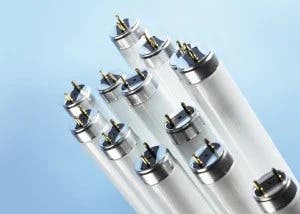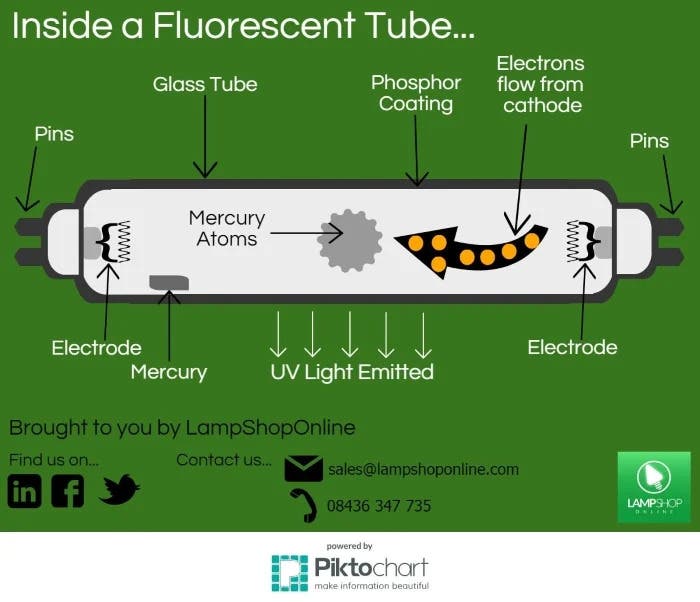How Do Fluorescent Tubes Work?
We stock tubes from leading brands at low prices, call 0113 8876270 to place an order.

How do they work?
Fluorescent tubes are a common sight in public places, offices and schools but how much do you actually know about the inner workings of the fluorescent lamp? Knowing how a lamp works can help you understand what might have happened when one stops working, making it easier to know how to fix it.
Below, we take a look at what's going on inside a fluorescent tube when you flick the light switch.
Where did it all begin?
According to the Smithsonian Institute in Washington, the fluorescent tube came about thanks to American electrical engineer and inventor Peter Cooper Hewitt's research into the work of physicist Julius Plucker and Heinrich Geissler, a glassblower. In 1901, when Hewitt passed an electric current through tiny amounts of mercury in one of Plucker's glass tubes, it lit up, making it the very first fluorescent tube to use mercury. These lamps work in much the same way today, with a few modifications of course.
What's inside the tube?
The inside of a fluorescent tube contains various chemical components and two electrodes at either end which are wired to an electrical circuit. These chemical components are:
- Inert gas
- Mercury
- Phosphor coating on the inside of the tube
The electrical circuit connects to an AC supply through contact pins at the end of the tube which connect to a light fitting. Inside the glass tube is a small amount of mercury and an inert gas like argon. If you've broken a fluorescent tube or come into contact with the inside of the tube you might have noticed a powder-like substance, this is the phosphor powder which coats the inside of the glass.
Turning the light on
The basic process of lighting a fluorescent tube involves an electrical current provoking chemical reactions which result in a light being emitted. This is what happens when you turn on the light:
- The current flows through the electrical circuit to the electrodes.
- Voltage from the electrodes causes electrons to migrate through the argon gas from one end of the tube to the other.
- The energy from this changes some of the liquid mercury into gas.
- As electrons and charged atoms move through the tube they will collide with the mercury gas atoms.
- The collisions excite the atoms so electrons increase in energy levels.
- When the electrons calm down and return to their original energy level they release light photons.
- These photons are ultraviolet but are made into visible light when they hit the phosphor coating of the tube.
- Manufacturers can offer different shades of lamps, such as warm white, cool white or even bright colours, by using a different blend of phosphors for each colour.
Fluorescent lights are more efficient than incandescent bulbs for two reasons:
- Incandescent bulbs create light through a heated filament and therefore create a lot of wasted energy through this heat, fluorescent tubes don't get as hot as the current flowing through them creates UV light at a low pressure. Fluorescent tubes do emit some heat but not as much as an incandescent bulb. The heat is dispersed quicker due to the larger size and it can vary on temperature depending what size they are.
- Although both incandescent and fluorescent lights use ultraviolet the fluorescent tube puts the excess ultraviolet light to work, whereas an incandescent bulb produces ultraviolet light but does nothing with it.
We might summarise the process as follows:
- Switch light on
- An electrical current makes mercury into gas
- Gaseous mercury collides with electrons and atoms
- Electrons get excited and increase in energy
- Electrons relax after time and energy level comes down
- This causes a release of light photons
- The photons hit phosphor and become visible light

Fluorescent Tube FAQs
Our in-depth guide answers your questions about fluorescent tubes and lamps so you can shop with us in confidence. If you can’t find an answer to your question here, don’t hesitate to contact us.
How much does it cost to run fluorescent tubes?
The cost to run fluorescent tubes depends on several factors: the wattage of the tube, the cost of electricity and whether you are using high frequency or switch start control gear. Lamps run much more efficiently when using high frequency ballasts but much more inefficiently when using switch start. Switch start ballasts will cause the lamp to use around 10% extra, so a 40w tube would run at 44w. If you change your 2ft T12 tube to a 2ft 18w tube, you go from a 20w tube to an 18w tube, thus costing less in electricity. If you changed your 2ft t8 fitting to a 2ft t5 fitting, you go from 18w down to 14w.
Are fluorescent tubes classed as dangerous or hazardous?
According to Mercury Recycling, the mercury from found in just one fluorescent tube can pollute 30,000 litres of water enough to make it unsafe for human consumption. This means that safe disposal of tubes is vital to minimise negative environmental impact and the risk of poisoning.
Fluorescent tubes are classified as hazardous waste and despite only posing a small risk to human health, they can cause environmental damage. Mercury Recycling recommends recycling, as opposed to disposing of, your fluorescent tubes as the safest and cheapest option. For more information, read our guide to fluorescent tube disposal.
Are fluorescent lamps suitable for fish tanks or aquariums?
Yes, and using them can be of great benefit to your fish. Read our guide for further information.
Can I grow plants using fluorescent lamps?
Yes, please read our in-depth guide on how to grow plants indoors using fluorescent lamps.
Do fluorescent tubes need a starter?
You will need a starter if you are running your tubes using switch start control gear. If you are using high frequency, a starter is not needed. If you are using 2ft 18w t8 tubes in series (more than one tube in the fitting), you will need a series starter. If you are running one tube between 4 and 65w you would use a universal starter. Any tubes over 65w need a high power starter.
Can you dim fluorescent tubes?
Yes, but a dimmable ballast and appropriate dimming system are required.
Can you paint fluorescent tubes?
This is not recommended, as fluorescent tubes get a little hot when in use. If you want a coloured tube, it’s best to buy one, or buy a coloured sleeve to place over the tube.
We sell a range of coloured fluorescent tubes in T5 or T8.
How many lumens are in one fluorescent tubes?
The lumen output depends on the wattage, our product descriptions show lumen outputs of each tube so you’ll have the exact information you need.
Why does my fluorescent tube keep flickering?
There will be a number of possible reasons for this. It could be the bulb, if it’s gone black on the ends it’s likely quite old and needs replacing. If it still flickers, the starter may have failed (in switch start circuits). If it still flickers, the ballast may be failing and will need replacing.
Read our troubleshooting guide for more information.
Why does my fluorescent tube keep flashing?
This will be because the starter or the ballast is not operating properly and may need replacing.
Why does my fluorescent tube keep blowing?
This may be because the ballast needs replacing. The ballast regulates the flow of electricity in to the lamp and towards the end of its lifetime, it may start to do this less effectively, sending to much or not enough current to the tube which has an adverse effect on the lamps average life.
Read our troubleshooting guide for more information.
 Please note: the information in this article is provided as a guide only. We strongly recommend speaking to an electrician before attempting any electrical work yourself. Any links included in this article are for information purposes only and Lamp Shop Online does not endorse the websites linked to.
Please note: the information in this article is provided as a guide only. We strongly recommend speaking to an electrician before attempting any electrical work yourself. Any links included in this article are for information purposes only and Lamp Shop Online does not endorse the websites linked to.
Published 2015/10/08
Shop now to replace your old fluorescent tubes
- If you need help finding the correct tube we are always here to help 0113 882 6270 -
